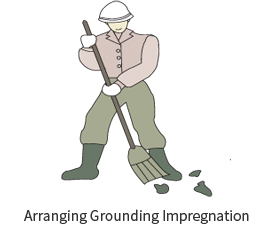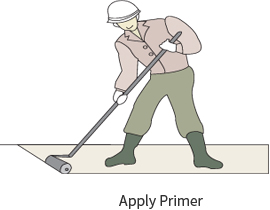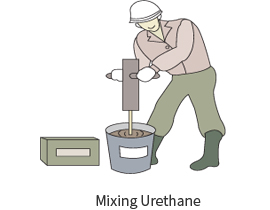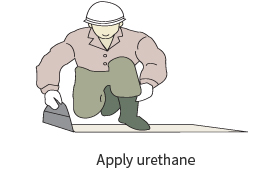주)페트로산업 메인 네비게이션
페트로산업 sub navigation
Exposed Urethane (PUW)
Petro-exposed urethane is a waterproof material developed by supplementing many defect factors such as smell, fire hazard, difficulty of work, and reduced water-resistance reliability in adhering parts of buildings such as apartments, buildings, and houses through waterproof and finishing techniques.
|
Strengths
Use
Packaging Unit
Mix Proportion
|
Construction Floor Plan

|
Quality Standard
- KS F 3211 (2015) : Construction Film Waterproofing material
| Item | Performance Standard | |||
|---|---|---|---|---|
| Tensile Performance Tensile Performance | Tensile Strength Tensile Strength (N/㎜²) | Above 2.5 | ||
| Coefficient of Expansion (%) | Above 450 | |||
| Tensile Product (N/㎜) | Above 294.2 More than 294.2 | |||
| Tearing Performance | Tearing Strength (N/㎜) | Above 14.7 | ||
| Reliability on Temperature | Tensile Strength Ratio (%) | -20 ℃ |
Above 100 Above 100 | |
60 ℃ |
Above 60 | |||
| Coefficient of Expansion between engagement portion during ruptureduring Rupture(%) |
-20 ℃ |
Above 250 Above 250 | ||
20 ℃ |
Above 300 Above 300 | |||
60 ℃ |
Above 200 Above 200 | |||
| Heat Expansion Characteristic | Expansion Rate (%) | Above -4, Below 1 Above -4, Below 1 | ||
| Tensile Performance | Tensile Strength Ratio (%) | Heat Treatment | Above 80, Below 150 Above 80, Below 150 | |
| Promotional Exposure Distance | Above 80, Below 150 Above 80, Below 150 | |||
| Alkali Treatment | Above 60, Below 150 Above 60, Below 150 | |||
| Acid Treatment Acid Treatment | Above 80, Below 150 Above 80, Below 150 | |||
| Coefficient of Expansion (%) | Heat Treatment | Above 400 | ||
| Promotional Exposure Treatment | Above 400 | |||
| Alkali Treatment | Above 400 | |||
| Acid Treatment | Above 400 | |||
| Deterioration during Elongation | Heat Treatment | There shall be no fractured balance or apparent deformation of any test. |
||
| Promotional Exposure Treatment | There shall be no fractured balance or apparent deformation of any test. |
|||
| Ozone Treatment | There shall be no fractured balance of apparent deformation on any test specimen. |
|||
| Adhesion Performance | Untreated | N/㎜² |
Above 0.7 | |
| After Repeated Cold Temperature Treatment | Above 0.5 | |||
| Coating State | No lifting or detachment of the coating shall be allowed on any test specimen. |
|||
| Fatigue Resistance | There shall be no perforation, tear, or fracture of the coating on any test specimen. |
|||
| Flow Resistance Performance | Flow Length (㎜) | No more than 3 on any test specimen | ||
| Crease Formation | Not on any test specimen. | |||
| Solid (%) | Indicator Value ±3 | |||
Construction Method
1. Arranging Grounding Impregnation |

|
2. Apply Primer |

|
3. Mixing Urethane |

|
4. Apply urethane |

|